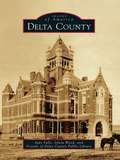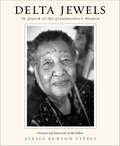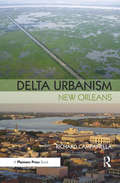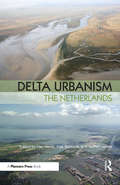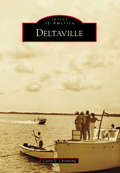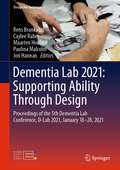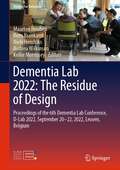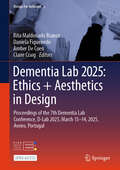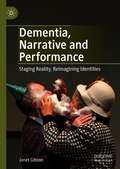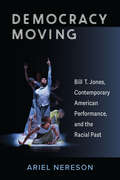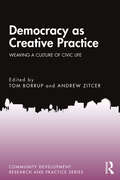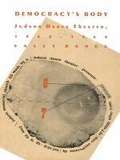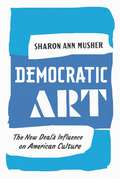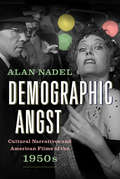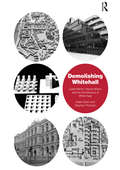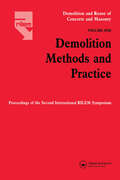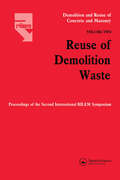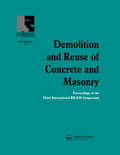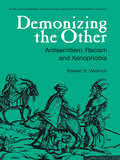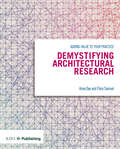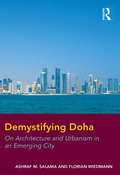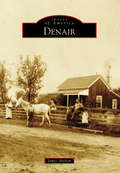- Table View
- List View
Delta County (Images of America)
by Sylvia Wood Judy Falls Friends of Delta County Public LibraryDuring the frenetic days of Reconstruction, Delta County claimed land between two branches of the Sulphur River, from Lamar and Hopkins Counties, and named itself after its shape and the third letter of the Greek alphabet. From its early days, Delta County became home to prosperous farmers who relocated from the South and who brought with them their knowledge of growing cotton as well as their traditions and cultures. At its heyday in the 1920s, the county boasted the densest rural population in the state. These pioneers believed strongly in education, and more than 40 schools dotted the county at one time, with many graduates of these rural schools becoming doctors, engineers, teachers, politicians, ministers, authors, musicians, lawyers, coaches, scientists, and athletes--as well as one All-American. For those who remained, those who returned, and those who chose this quiet corner of Northeast Texas, Delta County is home, with all the sweet and poignant implications of that word.
Delta Jewels: In Search of My Grandmother's Wisdom
by Alysia Burton SteeleInspired by memories of her beloved grandmother, photographer and author Alysia Burton Steele -- picture editor on a Pulitzer Prize-winning team -- combines heart-wrenching narrative with poignant photographs of more than 50 female church elders in the Mississippi Delta. These ordinary women lived extraordinary lives under the harshest conditions of the Jim Crow era and during the courageous changes of the Civil Rights Movement. With the help of local pastors, Steele recorded these living witnesses to history and folk ways, and shares the significance of being a Black woman -- child, daughter, sister, wife, mother, and grandmother in Mississippi -- a Jewel of the Delta. From the stand Mrs. Tennie Self took for her marriage to be acknowledged in the phone book, to the life-threatening sacrifice required to vote for the first time, these 50 inspiring portraits are the faces of love and triumph that will teach readers faith and courage in difficult times.
Delta Urbanism: New Orleans
by Richard CampanellaThis volume of APA's Delta Urbanism series traces the development of New Orleans from precolonial times to post-Katrina realities, in the context of the deltaic plain on which it lies. The book describes the underlying physical terrain and covers the various transformations humans have made to it: site selection, settlement, urbanization, population, expansion, drainage, protection, exploitation, devastation, and recovery. What New Orleans has experienced foretells what similar cities will be tackling in years to come.
Delta Urbanism: The Netherlands
by Han Meyer Steffen Nijhuis Inge BobbinkDelta Urbanism is a major new initiative that explores the growth, development, and management of deltaic cities and regions, with the aim of balancing various goals in a sustainable manner: urbanization, port commerce, industrial development, flood defense, public safety, ecological balance, tourism, and recreation. This book is a detailed history and overview of how one low-lying country has developed the policies, tools, technology, planning, public outreach, and international cooperation needed to save their populated deltas.
Deltaville
by Larry S. ChowningIn the early 20th century, the communities previously recognized as Sandy Bottom, Enoch, Stingray Point, Ruark, Amburg, Stove Point, Horse Shoe Bend, Pace's Neck, and Grinels became part of what is known today as Deltaville. Strategically located between two major rivers and the Chesapeake Bay, Deltaville has been center stage to many events that have shaped the nation. During the Revolutionary War and the War of 1812, friend and foe visited its shores. Six decades later, both Union and Confederate blood was spilled on its ground. Throughout the early 20th century, Deltaville's shores played a large part in local industry. Common occupations included wooden boatbuilding, freighting, oystering, crabbing, and fishing. By the end of the century, the community had grown into a waterfront resort and served as a playground for recreational boaters and visitors.
Dementia Lab 2021: Proceedings of the 5th Dementia Lab Conference, D-Lab 2021, January 18–28, 2021 (Design For Inclusion #2)
by Rens Brankaert Caylee Raber Maarten Houben Paulina Malcolm Jon HannanThis book gathers revised and selected contributions to the 5th Dementia Lab Conference, D-Lab 2021, organized online on January 18-28, 2021, from the Emily Carr University of Art + Design, Vancouver, Canada. It describes original strategies in which design or creative methods have been shown to uncover, support and enhance the abilities of people living with dementia. Papers report on new ideas and findings relating to three main themes: engagement, empowerment and identity. They cover: ethics of inclusion and solutions for shifting the culture of care to be focused on both personal independence and reconnecting with the community; new ways of designing with people living with dementia; strategies for breaking negative stereotypes and preconceived opinions; and approaches to retaining personhood and dignity. Offering a timely source of information on new design and creative methods to a broad community of industrial, communication, interactive and inclusive designers, this book is also meant to address and inspire various stakeholders and organizations in dementia care.
Dementia Lab 2022: Proceedings of the 6th Dementia Lab Conference, D-Lab 2022, September 20–22, 2022, Leuven, Belgium (Design For Inclusion #3)
by Rens Brankaert Maarten Houben Niels Hendriks Andrea Wilkinson Kellie MorrisseyThis book gathers the revised and selected contributions to the 6th Dementia Lab Conference, D-Lab 2022, held on September 20-22, 2022, in Leuven. It describes original and innovative research on how design can contribute to the quality of life of people with dementia, their loved ones, and caregivers. The papers highlight the value of participation within design, analyzing it at three levels: personal, product, and organizational. The presented ideas and findings address ‘The Residue of Design’ and go beyond the initial impact of the design itself by looking at what benefits design research brings for people with dementia. The papers cover topics such as the development of creative design methods to foster participation and engagement from people with dementia, evaluation studies or critical reflections that reveal the impact of products and the built environment in dementia care, and raising awareness and countering stigma in societal views on dementia.
Dementia Lab 2025: Proceedings of the 7th Dementia Lab Conference, D-Lab 2025, March 13–14, 2025, Aveiro, Portugal (Design For Inclusion #5)
by Claire Craig Rita Maldonado Branco Daniela Figueiredo Amber De CoenThis is an open access book. It gathers revised and selected contributions to the 7th Dementia Lab Conference, D-Lab 2025, held on March 13–14, 2025, in Aveiro, Portugal, reporting on innovative research aimed at improving the lives of people with dementia, their loved ones, and their caregivers. This edition addresses the theme of ethics + aesthetics in design. Ethics emphasize justice, advocate for inclusive, person-centred practices, and challenge societal stigmas. Aesthetics, beyond beauty, focus on sensory and emotional engagement, which becomes increasingly significant as dementia progresses. Together, these principles guide innovative design approaches that enhance care, identity, and connection. Being organized into three themes, Designing with People with Dementia, Including Design in Dementia Care, and Design within Cultures of Care, this collection highlights research on participation, technology, and the cultural dimensions of care. It also demonstrates the key role of design in creating products and environments that embrace aesthetic value and is expected to challenge stigmas and unrealistic assumptions about people living with dementia
Dementia, Narrative and Performance: Staging Reality, Reimagining Identities
by Janet GibsonFocusing mainly on case studies from Australia and the United States of America, this book considers how people with dementia represent themselves and are represented in ‘theatre of the real’ productions and care home interventions, assessing the extent to which the ‘right kind’ of dementia story is being affirmed or challenged. It argues that this type of story — one of tragedy, loss of personhood, biomedical deficit, and socio-economic ‘crisis — produces dementia and the people living with it, as much as biology does. It proposes two novel ideas. One is that the ‘gaze’ of theatre and performance offers a reframing of some of the behaviours and actions of people with dementia, through which deficit views can be changed to ones of possibility. The other is that, conversely, dementia offers productive perspectives on ’theatre of the real’. Scanning contemporary critical studies about and practices of ‘theatre of the real’ performances and applied theatre interventions, the book probes what it means when certain ‘theatre of the real’ practices (specifically verbatim and autobiographical) interact with storytellers considered, culturally, to be ‘unreliable narrators’. It also explores whether autobiographical theatre is useful in reinforcing a sense of ‘self’ for those deemed no longer to have one. With a focus on the relationship between stories and selves, the book investigates how selves might be rethought so that they are not contingent on the production of lucid self-narratives, consistent language, and truthful memories.
Democracy Moving: Bill T. Jones, Contemporary American Performance, and the Racial Past (Theater: Theory/Text/Performance)
by Ariel NeresonOn the 200th anniversary of Abraham Lincoln’s birth, renowned choreographer and director Bill T. Jones developed three tributes: Serenade/The Proposition, 100 Migrations, and Fondly Do We Hope . . . Fervently Do We Pray. These widely acclaimed dance works incorporated video and audio text from Lincoln’s writings as they examined key moments in his life and his enduring legacy. Democracy Moving explores how these works provided both an occasion and a method by which democracy and history might be reconceived through movement, positioning dance as a form of both history and historiography. The project addresses how different communities choose to commemorate historical figures, events, and places through art—whether performance, oratory, song, statuary, or portraiture—and in particular, Black US American counter-memorial practices that address histories of slavery. Advancing the theory of oscillation as Black aesthetic praxis, author Ariel Nereson celebrates Bill T. Jones as a public intellectual whose practice has contributed to the project of understanding America’s relationship to its troubled past. The book features materials from Bill T. Jones/Arnie Zane Company’s largely unexplored archive, interviews with artists, and photos that document this critical stage of Jones’s career as it explores how aesthetics, as ideas in action, can imagine more just and equitable social formations.
Democracy Moving: Bill T. Jones, Contemporary American Performance, and the Racial Past (Theater: Theory/Text/Performance)
by Ariel NeresonOn the 200th anniversary of Abraham Lincoln’s birth, renowned choreographer and director Bill T. Jones developed three tributes: Serenade/The Proposition, 100 Migrations, and Fondly Do We Hope . . . Fervently Do We Pray. These widely acclaimed dance works incorporated video and audio text from Lincoln’s writings as they examined key moments in his life and his enduring legacy. Democracy Moving explores how these works provided both an occasion and a method by which democracy and history might be reconceived through movement, positioning dance as a form of both history and historiography. The project addresses how different communities choose to commemorate historical figures, events, and places through art—whether performance, oratory, song, statuary, or portraiture—and in particular, Black US American counter-memorial practices that address histories of slavery. Advancing the theory of oscillation as Black aesthetic praxis, author Ariel Nereson celebrates Bill T. Jones as a public intellectual whose practice has contributed to the project of understanding America’s relationship to its troubled past. The book features materials from Bill T. Jones/Arnie Zane Company’s largely unexplored archive, interviews with artists, and photos that document this critical stage of Jones’s career as it explores how aesthetics, as ideas in action, can imagine more just and equitable social formations.
Democracy as Creative Practice: Weaving a Culture of Civic Life (ISSN)
by Tom Borrup Andrew ZitcerDemocracy as Creative Practice: Weaving a Culture of Civic Life offers arts-based solutions to the threats to democracies around the world, practices that can foster more just and equitable societies. Chapter authors are artists, activists, curators, and teachers applying creative and cultural practices in deliberate efforts to build democratic ways of working and interacting in their communities in a range of countries including the United States, Australia, Portugal, Nepal, the United Kingdom, and Canada. The book demonstrates how creativity is integrated in place-based actions, aesthetic strategies, learning environments, and civic processes. As long-time champions and observers of community-based creative and cultural practices, editors Tom Borrup and Andrew Zitcer elucidate work that not only responds to sociopolitical conditions but advances practice. They call on artists, funders, cultural organizations, community groups, educational institutions, government, and others to engage in and support this work that fosters a culture of democracy.This book is intended for undergraduate and graduate students in the humanities and social sciences, activists, funders, and artists who seek to understand and effect change on local and global scales to preserve, extend, and improve practices of democracy.
Democracy's Body: Judson Dance Theatre, 1962–1964
by Sally BanesDemocracy's Body offers a lively, detailed account of the beginnings of the Judson Dance Theater--a popular center of dance experimentation in New York's Greenwich Village--and its place in the larger history of the avant-garde art scene of the 1960s. JDT started when Robert Dunn, a student of John Cage, offered a dance composition class in Merce Cunningham's studio. The performers--many of whom included some of the most prominent figures in the arts in the early sisties--found a welcome performance home in the Judson Memorial Church in the Village. Sally Banes's account draws on interviews, letters, diaries, films, and reconstructions of dances to paint a portrait of the rich culture of Judson, which was the seedbed for postmodern dance and the first avant-garde movement in dance theater since the modern dance of the 1930s and 1940s. Originally published in 1983, this edition brings back into print a highly regarded work of dance history.
Democratic Art: The New Deal's Influence on American Culture
by Sharon Ann MusherThroughout the Great Recession American artists and public art endowments have had to fight for government support to keep themselves afloat. It wasn't always this way. At its height in 1935, the New Deal devoted $27 million--roughly $461 million today--to supporting tens of thousands of needy artists, who used that support to create more than 100,000 works. Why did the government become so involved with these artists, and why weren't these projects considered a frivolous waste of funds, as surely many would be today? In Democratic Art, Sharon Musher explores these questions and uses them as a springboard for an examination of the role art can and should play in contemporary society. Drawing on close readings of government-funded architecture, murals, plays, writing, and photographs, Democratic Art examines the New Deal's diverse cultural initiatives and outlines five perspectives on art that were prominent at the time: art as grandeur, enrichment, weapon, experience, and subversion. Musher argues that those engaged in New Deal art were part of an explicitly cultural agenda that sought not just to create art but to democratize and Americanize it as well. By tracing a range of aesthetic visions that flourished during the 1930s, this highly original book outlines the successes, shortcomings, and lessons of the golden age of government funding for the arts.
Demographic Angst: Cultural Narratives and American Films of the 1950s
by Alan NadelProlific literature, both popular and scholarly, depicts America in the period of the High Cold War as being obsessed with normality, implicitly figuring the postwar period as a return to the way of life that had been put on hold, first by the Great Depression and then by Pearl Harbor. Demographic Angst argues that mandated normativity—as a political agenda and a social ethic—precluded explicit expression of the anxiety produced by America’s radically reconfigured postwar population. Alan Nadel explores influential non-fiction books, magazine articles, and public documents in conjunction with films such as Singin’ in the Rain, On the Waterfront, Sunset Boulevard, and Sayonara, to examine how these films worked through fresh anxieties that emerged during the 1950s.
Demokratie und Soziale Arbeit: Sensibilisierung für die Wahrnehmung und Veränderung von Ungleichheiten in unserer Gesellschaft
by Monika Alamdar-Niemann Bärbel Schomers Marion TackeDer Tagungsband „Demokratie und Soziale Arbeit“ befasst sich aus unterschiedlichen Perspektiven mit zentralen aktuellen Fragen der Sozialen Arbeit. Wie kann Teilhabe und Partizipation in der Gesellschaft ungeachtet der sozialen Lage der Adressat*innen, ihres Geschlechts, ihrer sexuellen Orientierung, ihrer ethnischen Herkunft und Hautfarbe, ihrer Religion und Sprache, ihres Alters und rechtlichen Status ermöglicht werden? Soziale Arbeit mit Blick auf die zugrundeliegenden strukturellen Mechanismen von Ausgrenzung und Abwertung zielt auf eine Humanisierung der deutschen Gesellschaft. Es geht um nicht weniger als die Professionalisierung einer Arbeit gegen Diskriminierung zur Wahrung demokratischer Prinzipien, denen sich die hier versammelten Autor*innen widmen.
Demolishing Whitehall: Leslie Martin, Harold Wilson and the Architecture of White Heat
by Adam Sharr Stephen ThorntonThis book is about a lost world, albeit one less than 50 years old. It is the story of a grand plan to demolish most of Whitehall, London’s historic government district, and replace it with a ziggurat-section megastructure built in concrete. In 1965 the architect Leslie Martin submitted a proposal to Charles Pannell, Minister of Public Building and Works in Harold Wilson’s Labour government, for the wholesale reconstruction of London’s ’Government Centre’. Still reeling from war damage, its eighteenth- and nineteenth-century palaces stood as the patched-up headquarters of an imperial bureaucracy which had once dominated the globe. Martin’s plan - by no means modest in conception, scope or scale - proposed their replacement with a complex that would span the roads into Parliament Square, reframing the Houses of Parliament and Westminster Abbey. The project was not executed in the manner envisaged by Martin and his associates, although a surprising number of its proposals were implemented. But the un-built architecture is examined here for its insights into a distinctive moment in British history, when a purposeful technological future seemed not just possible but imminent, apparently sweeping away an anachronistic Edwardian establishment to be replaced with a new meritocracy forged in the ’white heat of technology’. The Whitehall plan had implications well beyond its specific site. It was imagined by its architects as a scientific investigation into ideal building forms for the future, an important development in their project to unify science and art. For the political actors, it represented a tussle between government departments, between those who believed that Britain needed to discard much of its Victorian and Edwardian decoration in the name of ’professionalization’ and those who sought to preserve its ornate finery. Demolishing Whitehall investigates these tensions between ideas of technology and history, science and art, socialism and el
Demolition Methods and Practice V1
by Y. KasaiThis book contains papers, presented at the Second International RILEM Symposium on Demolition and Reuse of Concrete and Masonry, held in Tokyo, Japan, in November 1988, on various demolition techniques and practice as well as demolition machines of concrete structures.
Demolition Reuse Conc Mason V2
by Y KasaiThis book includes papers on demolition methods and practice and reuse of demolition waste, presented at RILEM symposium held in Japan. The papers contribute to the development of demolition and reuse of concrete and masonry structures.
Demolition and Reuse of Concrete and Masonry: Proceedings of the Third International RILEM Symposium
by Erik K. LauritzenThis book forms the Proceedings of the Third International RILEM Symposium in Odense, Demark in October 1993. It includes reviews and reports of recent developments in the fields of demolition techniques and reuse of waste building materials, and focusses on the integration of demolition and recycling operations in the construction and housing indu
Demonizing the Other: Antisemitism, Racism and Xenophobia
by Robert S. WistrichAt the close of the twentieth century the stereotyping and demonization of 'others', whether on religious, nationalist, racist, or political grounds, has become a burning issue. Yet comparatively little attention has been paid to how and why we fabricate images of the 'other' as an enemy or 'demon' to be destroyed. This innovative book fills that gap through an interdisciplinary, cross-cultural approach that brings together a distinguished array of historians, anthropologists, psychologists, literary critics, and feminists.The historical sweep covers Greco-Roman Antiquity, the MIddle Ages, and the MOdern Era. Antisemitism receives special attention because of its longevity and centrality to the Holocaust, but it is analyzed here within the much broader framework of racism and xenophobia. The plurality of viewpoints expressed in this volume provide fascinating insights into what is common and what is unique to the many varieties of prejudice, stereotyping, demonization, and hatred.
Demons in the Spring: Stories
by Joe MenoDemons in the Spring is a collection of twenty short stories by Joe Meno, author of the smash hits The Boy Detective Fails and Hairstyles of the Damned, with illustrations by twenty artists from the fine art, graphic art, and comic book worlds--Todd Baxter, Kelsey Brookes, Ivan Brunetti, Charles Burns, Nick Butcher, Steph Davidson, Evan Hecox, Kim Hiorthoy, Paul Hornschemeier, Cody Hudson, Caroline Hwang, kozyndan, Geoff McFetridge, Anders Nilsen, Laura Owens, Archer Prewitt, Jon Resh, Jay Ryan, Souther Salazar, Rachell Sumpter, and Chris Uphues.Oddly modern moments which occur in the most familiar of public places, from offices to airports to schools to zoos to emergency rooms: a young girl who refuses to go anywhere unless she's dressed as a ghost; a bank robbery in Stockholm gone terribly wrong; a teacher who's become enamored with the students in his school's Model United Nations club; a couple affected by a strange malady-a miniature city which has begun to develop in the young woman's chest, these inventive stories are hilarious, heartbreaking, and unusual.Joe Meno is the best-selling author of the novels Hairstyles of the Damned, The Boy Detective Fails, How the Hula Girl Sings, and Tender As Hellfire. He was the winner of the 2003 Nelson Algren Award for short fiction and is a professor of creative writing at Columbia College Chicago.*A portion of the author's proceeds from the book will go directly to benefit 826 CHICAGO, a nonprofit tutoring center, part of the national organization of tutoring centers with branches in San Francisco, Los Angeles, New York City, and Seattle.*
Demystifying Architectural Research: Adding Value to Your Practice
by Flora Samuel Anne DyeThis practical, hands on introduction guides you through the basics of undertaking research in day-to-day architectural practice helping you to exploit the growing opportunities on offer. It explores how developing a research specialism can improve the quality of your projects, help to define your brand and generate new channels of revenue with innovative services for clients. The text is divided into four sections focussing on different types of Architecture Research Practice; commercial, cultural, social and technology. Each section includes a series of inspiring case studies written by practitioners themselves on the way in which research benefits their business as well as an essay by an expert which sets these projects in their methodological context. In this way the book highlights the broad spectrum of research being undertaken and the practical implications for the practice and their projects. This is designed for architects and practices who want to develop a clear specialism that adds brand value and will enable them to access new funding streams as well as students of architecture who are getting to grips with architectural research.
Demystifying Doha: On Architecture and Urbanism in an Emerging City
by Ashraf M. Salama Florian WiedmannOver the past decade or so, the wealth produced by Qatar's oil and gas exports has generated a construction development boom in its capital city of Doha and the surrounding vicinity. Since the late 1990s, the number of inhabitants has grown from less than 400,000 to more than 1.7 million today. In many respects, Doha is portrayed as an important emerging global capital in the Gulf region, which has been positioning and re-inventing itself on the map of international architecture and urbanism, with a global image of building clusters of glass office towers, as well as cultural and educational facilities. While focusing on the architectural and planning aspects of Doha's intensive urbanization, this first comprehensive examination of the city sets this within the socio-political and economic context of the wider Arabian Peninsula. 'Demystifying Doha - On Architecture and Urbanism in an Emerging City' features a comprehensive discussion on contemporary architecture and urbanism of Doha as an emerging regional metropolis. It provides a critical analysis of the evolution of architecture and urbanism as products of the contemporary global condition. Issues that pertain to emerging service hubs, decentralised urban governance, integrated urban development strategies, image-making practices, urban identity, the dialectic relations between the city and its society and sustainable urbanism are all examined to elucidate the urban evolution and the contemporary condition of Doha. 'Demystifying Doha - On Architecture and Urbanism in an Emerging City' concludes by suggesting a framework for future studies of the city as well as for investigating the future of similar cities, setting out an agenda for sustainable urban growth, while invigorating the multiple roles urban planners and architects can play in shaping this future.
Denair (Images of America)
by James ShehanRancher John T. Davis first established Davis Ranch in 1871, but it would be over 30 years before the land was declared the town of Denair. Tucked away in the San Joaquin Valley, this small oasis offered an abundance of fertile land and water, as well as close proximity to the expanding railroad. Originally considered the townsite of Elmwood, it was renamed Denair on April 14, 1907, for John Denair, a Santa Fe railroad man and land developer who had purchased 9,000 acres in the area. Over the next 100 years, the settlement of Denair slowly grew. Businesses came and went. Families and farms appeared and then disappeared like shifting sands, only to be replaced by others years later. In Denair, nothing ends--it just changes.
